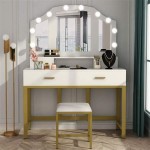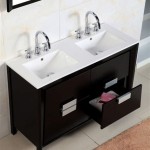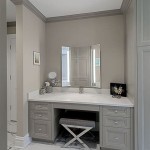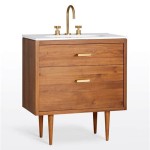Laminate Vanity Tops For Bathrooms: A Comprehensive Guide
Laminate vanity tops are a popular choice for bathroom renovations and new constructions due to their affordability, versatility, and relatively low maintenance requirements. They provide a practical and aesthetically pleasing surface for sinks, storage, and everyday bathroom activities. This article provides a detailed overview of laminate vanity tops, covering their composition, advantages, disadvantages, design options, installation considerations, and maintenance procedures.
Laminate, in its most basic form, is a composite material. It consists of multiple layers bonded together under high pressure and heat. The core material, often particleboard or MDF (Medium-Density Fiberboard), provides the structural foundation for the vanity top. This core is then covered with decorative paper or fabric that has been saturated with resins. The final layer is a clear protective overlay, typically made of melamine or acrylic, which offers resistance to scratches, moisture, and stains. The specific composition and quality of the laminate material determine its overall durability and performance.
The manufacturing process involves several stages. First, the core material is cut to the desired size and shape. The decorative layer, printed with various patterns and colors, is then applied to the core. Following this, the protective overlay is added, and the entire assembly is pressed together under high pressure and heat. This process fuses the layers into a single, solid surface. The edges of the laminate vanity top are often finished with a matching laminate strip or a more durable edging material, such as PVC or solid surface, to protect the core from moisture intrusion.
Affordability and Cost-Effectiveness
One of the primary advantages of laminate vanity tops is their cost-effectiveness compared to other materials such as granite, quartz, or solid surface. The lower material costs and simpler manufacturing processes translate into a significantly more affordable option for homeowners and contractors. This makes laminate an attractive choice for budget-conscious bathroom renovations or in situations where multiple bathrooms need to be updated.
The cost difference can be substantial. A laminate vanity top typically costs a fraction of the price of a comparable granite or quartz top. This allows homeowners to allocate their budget to other aspects of the bathroom renovation, such as upgraded fixtures, flooring, or lighting. The affordability of laminate also makes it a practical choice for rental properties or frequently remodeled spaces, where longevity and maximum resale value may not be the primary concerns.
While the initial cost is lower, it's important to consider the long-term value proposition. While laminate may not last as long as more expensive materials, its ease of replacement and relatively low cost make it a viable option for many homeowners. If properly maintained, a laminate vanity top can provide years of reliable service at a fraction of the cost of its higher-end counterparts.
Design Versatility and Aesthetic Options
Laminate vanity tops offer a wide range of design versatility, allowing homeowners to achieve a variety of aesthetic styles. The decorative layer of the laminate can be printed with virtually any pattern or color, including realistic imitations of natural stone, wood grain, and abstract designs. This allows for seamless integration with various bathroom decor schemes.
The availability of diverse edge profiles further enhances the design flexibility of laminate vanity tops. Options range from simple square edges to more elaborate beveled or ogee edges, allowing for customization to match the desired aesthetic. These edge profiles can be applied using laminate strips or, for increased durability, with solid surface or PVC edging.
Beyond color and pattern, laminate vanity tops can also be textured to mimic the look and feel of natural materials. Embossed textures can create the illusion of wood grain, stone, or even textured fabrics. This adds another layer of visual interest and realism to the laminate surface, making it difficult to distinguish from more expensive materials at first glance.
The consistent color and pattern reproduction of laminate also offer an advantage over natural materials, which can exhibit variations in color, veining, and texture. This consistency allows for precise matching of multiple vanity tops within the same bathroom or across different bathrooms. It also simplifies the process of ordering replacement pieces, as the color and pattern will be identical to the original.
Maintenance and Durability Considerations
Laminate vanity tops are relatively easy to maintain, requiring only regular cleaning with mild soap and water. The protective overlay provides a barrier against stains and moisture, preventing liquids from seeping into the core material. This makes laminate a hygienic and practical choice for bathrooms, where spills and splashes are common.
However, while laminate is resistant to stains and moisture, it is not completely impervious. Prolonged exposure to standing water can eventually cause the core material to swell and delaminate. It is important to promptly wipe up spills and avoid leaving wet items, such as damp cloths or sponges, on the surface for extended periods.
Laminate is also susceptible to scratches and abrasions. While the protective overlay offers some resistance, sharp objects and abrasive cleaners can damage the surface. It is recommended to use cutting boards when preparing toiletries and avoid using harsh scouring pads or abrasive cleaners. Over time, minor scratches and scuffs can accumulate, diminishing the appearance of the vanity top.
Heat resistance is another important consideration. Laminate is not designed to withstand prolonged exposure to high heat. Hot curling irons, hair dryers, and other heat-generating appliances should not be placed directly on the laminate surface. Using heat-resistant mats or trivets can help protect the vanity top from heat damage.
The durability of a laminate vanity top is also influenced by the quality of the materials and the manufacturing process. High-quality laminates with thicker protective overlays and denser core materials tend to be more durable and resistant to damage. It is important to choose a reputable brand and carefully inspect the vanity top for any defects before installation.
Repairing laminate vanity tops can be challenging. Minor scratches can sometimes be concealed with touch-up kits or colored markers, but more significant damage, such as chips or delamination, often requires professional repair or replacement. In some cases, it may be more cost-effective to replace the entire vanity top rather than attempt a repair.
Installation of laminate vanity tops is generally straightforward and can be accomplished by experienced DIYers or professional installers. The vanity top is typically attached to the cabinet base using screws or adhesive. Proper sealing around the sink and backsplash is essential to prevent water damage. It is important to follow the manufacturer's instructions carefully to ensure a secure and watertight installation.
In summary, laminate vanity tops offer a compelling combination of affordability, design versatility, and ease of maintenance. While they may not be as durable or luxurious as some higher-end materials, they provide a practical and cost-effective solution for bathroom renovations and new constructions. By understanding the advantages and limitations of laminate, homeowners can make informed decisions and choose the right vanity top for their needs and budget.

New Bathroom Countertops

The New Era Of Laminate Countertops Why They Rock Review

New Bathroom Countertops

New Bathroom Countertops

Ask The Experts Substrates And Sinks For Hpl

Er S Guide Laminate Countertops Formica Group

Bathroom Remodel

Er S Guide Laminate Countertops Formica Group

New Bathroom Countertops

Laminate Countertops Traditional Bathroom Grand Rapids By Degraaf Interiors







